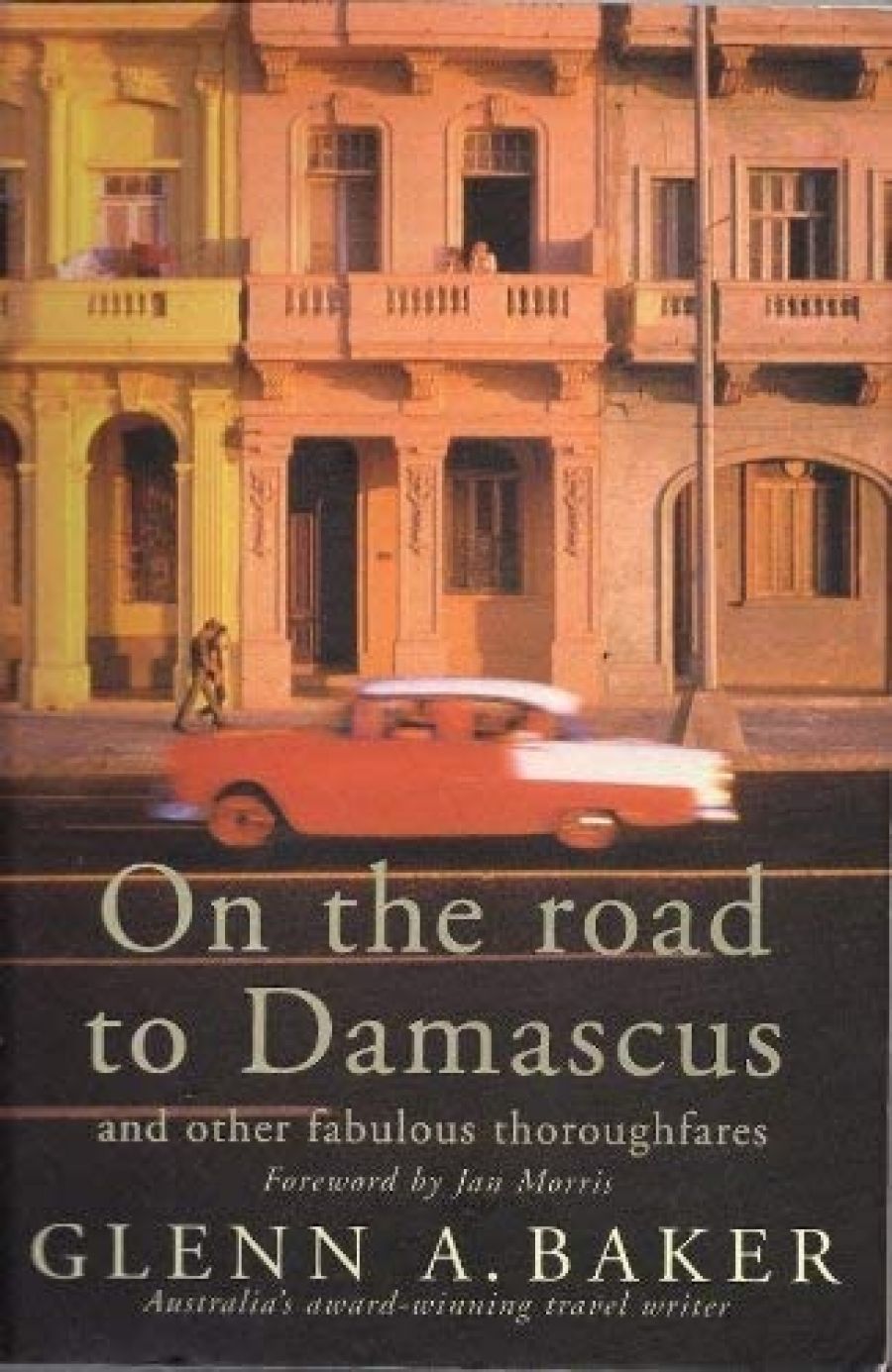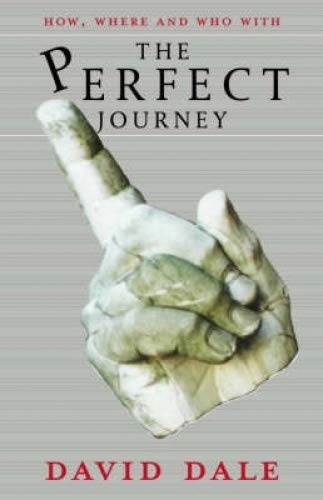
- Free Article: No
- Contents Category: Travel
- Review Article: Yes
- Article Title: Travelling heads
- Online Only: No
- Custom Highlight Text:
The question remains – where is St John the Baptist’s head? David Dale and Glenn A. Baker are both formidable travellers and reliable chroniclers. Both claim to have been in close proximity to the detached cranium of this biblical hero, but in different countries: Dale in the north of France, Baker in Damascus.
- Book 1 Title: On the Road to Damascus and Other Fabulous Thoroughfares
- Book 1 Biblio: Viking, 320pp, $28 pb
- Book 2 Title: The Perfect Journey
- Book 2 Biblio: Picador, 298pp, $21 pb
- Book 2 Cover Small (400 x 600):

The two books sit well together, and provide as comprehensive an answer as possible to the rhetorical question – why travel anyway? For Dale, it is basically food, people and history. Don’t mention scenery. Dale was numbingly bored as a kid, dragged on coach tours by his parents in search of ‘gorgeous scenery’. Dale soon decided the word ‘coach’ must derive from a football or tennis coach, ‘someone who draws up a rigid timetable to drag you through repetitive discomfort’. Early in his peripatetic life, Dale preferred to travel alone, until marriage and a child introduced him to different travel dimensions and the realisation that his daughter could engender warmth from that most formidable bastion of human remoteness, a French waiter. He also counsels against travelling with a casual acquaintance. Ernest Hemingway was once asked about a motoring holiday he had taken around France with F. Scott Fitzgerald: ‘Never go on trips with anyone you do not love.’
Dale is an adventurous eater, and a member of L’Unione Ristorante del Buon Recordo (literally, ‘the restaurant of good memory’). Some of their dishes would be hard to forget –horse stew, snail soup or calf’s intestines. Dale combines this adventurous gastronomy with a morbid desire to visit places where famous people carked. The Place de Théâtre in Arras drew him like a magnet. It was there that the guillotine did its ghastly work during the French Revolution. With careful planning, these two elements of perfect travel, food and retrospective horror, can be enjoyed together.
Consulting The Food of France guidebook (by the deliciously named Waverley Root), Dale found himself in the north of France not only dining directly under the room where Vincent van Gogh breathed his last but ‘at one point we may have been two metres from the head of John the Baptist, though I wouldn’t want to press this claim too strongly’.
Dale’s engaging and eclectic narrative is full of valuable travel tips. It is essential, for instance, when climbing the much-patronised mountain from which Moses brought down his inscribed tablets of stone, to take your own toilet paper. He has a good eye for the absurd. In Paris: ‘I noticed a small sign advising that certain numbered seats were reserved for people mutilées de cul (wounded in the bum). I was impressed by the tenderness of the transport authorities in providing soft seating for the anally injured, until closer inspection revealed that the sign actually reserved the seats for people mutilées de guerre (wounded in war).’
Taking to extremes his mantra that ‘it’s the souvenirs you don’t get you regret all your life’, Dale admits to being a frightful kleptomaniac, unashamedly stealing cutlery, monogrammed towels, embossed stationery and ashtrays from hotels. Another of his on-the-road eccentricities is an addiction to historic guidebooks. (My illustrious Uncle Philip, a Cambridge don and a Fellow of the Royal Society, once told me he actually saw an English-to-French guide that featured the useful phrase: ‘My postillion has been struck by lightning’.)
Dale professes a certain high-mindedness about sponsored travel, electing to pay his own way or to be sent by the Sydney Morning Herald. Glenn A. Baker, however, goes cheerfully where anyone pays him to. (Check out his generous acknowledgments.) His delightful essay about a stay at the Savoy Hotel in London was almost certainly the result of a freebie. How else do ordinary mortals get to the Savoy? But he is too experienced a writer to fall into the PR trap. Jan Morris, no mean wordsmith herself, gives Baker full marks for reportage, memoir, sidelights of history, personal portraits, and anthropological asides. ‘There may even be, if I may dare suggest it, an occasional streak of fiction, and certainly the whole fizzy mélange is enlivened by the author’s perpetually lively imagination.’
Baker takes us to more countries than Dale, whose passion for French offal keeps him mainly in Europe. Cuba, Scandinavia, the Middle East, the USA, Australia, Papua New Guinea, Vietnam, the Falkland Islands, the Channel Islands, Cambodia, East Timor and, of course, Damascus feature in Baker’s essays. Like Dale, he loves travel guides, but being a rock music historian is likely to have Fodor’s Guide for the Rock ‘n’ Roll Traveller rather than the gastronomic observations of Waverley Root. Had you gone to Manchester’s Plaza Nightclub in 1961, you could have scored a free polio jab! They just don’t have club promotions like that anymore.
Baker is a fine descriptive writer. Fascinated by Cuba’s time warp in 1995 (changes have since occurred), he wrote:
Today [Castro’s] Havana offers the ultimate tropical decay – not a lick of paint applied to public buildings in thirty-six years (many of them still pockmarked with scores of bullet and mortar shell holes); no discernible civic maintenance or repair programs; streets empty of pretty much anything except fabulous fifties finned wonders from a then-dominant Detroit – Chevvies, Caddies, Oldsmobiles, Dodges and flash Fords held together with wire, spit and unsanctioned prayers; bars with Hemingway’s signed chits pinned to the walls; rusted wrought-iron balconies; clap-boarded cinemas; amateur Ava Gardner hairdos and heavy Chinese bicycles probably discarded after the Long March. All told the most glorious decrepitude to be found in the Americas. A whole nation frozen in time.
Baker is a dab hand with the clever phrase. Near Damascus, wealthy nomadic Bedouin tribesmen park cars and trucks beside their traditional animal hide tents. ‘It seems that camels just don’t have enough cylinders.’
Some of Baker’s finest work in this anthology is found in his description of the country near Condobolin where he grew up as a ‘near-feral pubescent boy forever asking questions’, close to the euphoniously titled Tullabong Tin Mine at Tallebung. ‘The summer heat was so intense one day that I walked under the air-conditioning of Thomas Watson Ltd General Store and fainted dead away.’
There are occasional stylistic lapses. The Highlands of New Guinea are, as he says, ‘surreal, and bizarre, and cosmic’ but, please Glenn, not ‘absolutely’ unique!
Baker’s eye is constantly observing the background detail, wherever he is. Last year in East Timor, he joined a crowd of people at the forbidding Santa Cruz Cemetery, part of the country’s killing fields. Moving away from the crush, he saw a small boy, about eight years old. Oblivious to the hubbub, the boy was tending a small makeshift grave probably containing a sibling and topped by a fragile wooden cross. With a small leafy branch, he was ‘meticulously sweeping the grave clean, going back and back again to pick up and discard twigs, stones, any detritus. It was an unhurried, determined process that concluded with him placing a small, upturned plastic cup at one end and then slipping away towards a break in the fence.’
Both these travel books are good value. But can anyone tell me where John the Baptist’s head actually is?


Comments powered by CComment